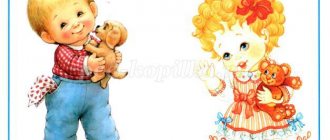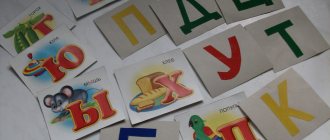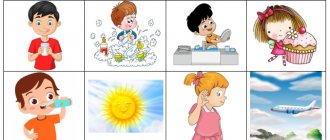Speech therapy lesson “Differentiation T-D” 1st grade
Topic: Differentiation T - D in syllables and words
Goal: Formation of the ability to isolate and distinguish sounds T-D in oral and written speech; clarification, expansion and activation of the dictionary; improvement of a detailed educational statement; development of attention, memory, stability and voluntary activity. Equipment. Pictures, signal cards, number series. Toys: kitten, bear cub, sets of geometric shapes, cards, colored pens, tangram.
Progress of the lesson
1. Organizational moment
The one who names words consisting of three syllables will sit down. Today we are going to our magical city of sounds and letters. But first, we need to prepare our speech apparatus. We sat down comfortably. Hands on knees.
2. Articulation gymnastics
"Smile." The thumbs and index fingers of the right and left hands are joined together. Steel fingers clenched into a fist. "Tube". Thumbs and index fingers joined together. Without opening, they move forward. "Spatula". The right and left palms are turned outward. "Cup". Cup-shaped palms. "Horse". Children march in place. "Fungus". The mushroom has grown - the legs are slightly bent, the knees look to the sides, the arms are raised above the head and bent at the elbows. Aging mushroom. The muscles relax, the mushroom ends up on the ground.
3. Voice exercises
We show the vowels a, o, u, y, e with movements. Gorka - we take the vowels out from under the bed and throw them on the closet and back.
4. Breathing exercises:
the balloon deflates, the balloon inflates. We move the walls. Relaxation: Ah, this spring sunny day.
5. Updating existing knowledge
- What is sound? - What is a letter? - What sounds are there? — How are vowel sounds pronounced? -What are they? — How are consonants pronounced? - What are the consonant sounds? - What is a syllable? -Which is longer, a syllable or a word?
6. Explanation of new material
In the city of sounds and letters there are always a lot of interesting poems and riddles, proverbs and tongue twisters. Say a familiar tongue twister in robot style: A woodpecker lived in an empty hollow, chiseling the oak tree like a chisel.
— What sounds are most often found in this tongue twister? (D-T)
From this series, name sounds similar in articulation: o, t, i, d, p, u. How are they similar? Comparison.
7. Consolidation of new material
1).We listen and memorize syllable series.
| Yes - ta To - do Dia - cha Tu - do Diti | ta - yes - ta yes - ta - yes those - those - de yes - ta - ta - yes yes - ta - ta - yes |
2) What letter represents the sounds t - t in writing? (letter “t”) What letter in the letter represents the sounds d – d? (letter “d”) Show on the table. 3) Reading syllable rows to music.
| Yes - do - do - dy Ta - that - here Di - de - dia - du | ti - te - cha - tu yes - to - du - you ti - de - dia - tu |
8. Finger gymnastics
Self-massage. Count your fingers. What words have the sounds d and d? (seventh, ninth, tenth) Which words have the sounds t and t? (second, third, fourth, fifth, sixth, ninth, tenth). Which words have both sounds? (ninth, tenth) What words do not have these sounds?
9. Open your notebooks and write down the date
Encrypt the words: if you hear a word with the sound d, draw a circle, if the word contains the sound t, draw a square. plate, pipe, traces, rooster. Now let's decipher these words. So…
10. Listen to the words and label them graphically.
Write the letters t and d above the corresponding syllable. Melon, road, woodpecker, skating rink, acorns.
11. Physical exercise.
Game “Listen to the Claps” One clap - stand up like a heron; Two claps - stand up like a soldier; Three claps - frog
12. Consolidation of new material
1) Sound-letter analysis of words based on pictures: duck, melon. 2) The kitten loves all objects that have the sound t or t, and the bear cub loves objects that have the sounds d and d. They took some of these objects with them on the road, but while they were driving, all the objects got mixed up, help them sort out their luggage . Shovel, picture, plate, star, sneakers, trumpet, honeycomb, pumpkin, apron, radio. Place objects with sounds t and t next to the kitten, and objects with sounds d and d next to the teddy bear. 3) Compare pairs of words by sound, spelling, meaning. Duck is a fishing rod. Write the words in your notebook. To make a sentence. Conclusion: sounds and letters should not be confused.
13. Lesson summary
So: A sound is what we are... A letter is what we are... Voiced consonant sounds are... D-D Voiceless consonant sounds are... T-T In writing, the sounds d and d are indicated by a letter. In writing, the sounds t and t are represented by a letter.
Author of the material: Kurbanova Zoya Efimovna
Also on topic:
T-D differentiation in words
Differentiation of paired consonant sounds D and T.
LESSON SUMMARY ON Speech Therapy (grade 8b, January 29, 2020)
Topic: Differentiation of paired consonant sounds D and T.
Goal: Differentiation of sounds [D] - [T].
Tasks:
- Educational: develop auditory differentiation of sounds [D] - [T].;
develop the ability to correlate the sounds [D] - [T] with the letters D and T;
- Correctional: develop phonemic hearing, phonemic perception. Clarification and comparison of articulation and characteristics of sounds [D] - [T]. Differentiation of sounds [D] - [T] in syllables, words, phrases, sentences, texts.
- Developmental: develop skills in the operations of phonemic analysis and synthesis; develop visual perception, thinking, auditory and visual memory, and expand vocabulary, develop coherent speech.
Equipment: pictures of the seasons, subject pictures, didactic material, algorithm, syllabic scheme.
Progress of the lesson.
I. Organizational moment.
- Guys, guests came to our lesson today. Let's welcome the guests.
- The one who can name the names of the seasons in the pictures will sit down. Look at the pictures and
determine what time of year is depicted on each of them.
- What time of year is it now? (winter).
II. Main part.
- Guys! Cheerful gnome brothers came to visit us from the fairy forest. One's name is T
Onyk, another
Donik
. They came to find out what we had already learned in class and, of course, to learn a lot from us.
- Characteristics of sounds T-D.
T
Onik and
Donik
believe that they have the same names. Is it so? Let's try to determine what the difference is in these names.
- That's right, the first sounds of names are different. Name these sounds.
- Now let's remember the characteristics of sounds D
and
T.
_ - Make sounds T
and
D.
_
What do lips do? Teeth? Language? (The tongue hits the upper teeth, the mouth is slightly open, the lips are smiling). - Place your hand on the neck and listen to whether the neck rings when you pronounce the sound D
?
Is this sound pronounced with or without a voice? (with a voice, ringing). - Now make a sound T
and listen, does your throat ring when you pronounce this sound?
(No).
The sound is pronounced without a voice
(voiceless). - What is the difference? (the sound “T” is unvoiced, and the sound “D” is voiced)
- How are the sounds similar? (The tongue knocks on the upper teeth, the lips smile, the air stream meets an obstacle, both sounds are consonants. They can be hard and soft).
2. Correlation between sound and letter.
- What are the sounds in writing indicated by? (letters)
- Remember what letter elements we need to write lowercase letters and compose these letters.
The letter D is like this house, T has turned into an antenna
We will live in it for a long time. And I found myself on the roof
3. Differentiation of sounds in syllables. Let's help Tonic and Donik understand the scheme.
Look at the diagram, compose and read the syllables.
Write down the syllables in pairs according to voicedness - voicelessness.
Indicate in them the presence of the sounds studied in the lesson.
4 Pure sayings.
Let's say pure sayings, and our gnimiki will listen to how we correctly pronounce syllables and words.
Ta-ta-ta - una broken purity
Ti-ti-ti- ate almost all the porridge
That's it - we started playing lotto
5 Game “The letters ran away.” Help the gnomes find the missing letters from the words. (Pictures)
Determine which sound in the word is D or T and the place of the sound in the word. Help Tonic collect pictures with the sound T, and Donik with the sound D:
Gift, glass, reel, machine, gate, house, gardener, postman, artist, seller, trough. Explain the meaning of each word. Make up sentences with these words.
6. Differentiation of sounds in words.
- Now let’s play with the gnome brothers the game “What is where?”
- We will write down the guessed word in a notebook and highlight the letters T-D.
Pictures: melon, chair, pencil, house, plate, cabbage, bucket, slippers, bus
.
- What's in the top left corner? What sound do we hear in this word? ( capusTA
). In the word cabbage I hear the sound “T”, it is consonant, unvoiced, which means I write the letter T, highlight the letter T.
- What's in the top right corner? ( Tplate
)
- What's in the bottom right corner? What sound do we hear in this word? ( chair ) _
- What's above the house? What sound do we hear in this word? ( Tapochki
)
- What's to the left of the house? What sound do we hear in this word? ( pencil ) _
- What is between the pencil and the chair? (dohm
)
- What's under the plate? ( bucket ) _
- What's to the right of the cabbage? ( dynya
)
- What's underneath the cabbage? ( awTobus
)
- Now let’s ask a question for each word: Which one? Which? Which?
7. Working with the proposal.
a) Help the gnomes ( compose and write down phrases and sentences ):
Name words-signs
.
b) Read the sentences , choosing words that match their meaning from brackets. Name
incomprehensible words.
8. Physical exercise
9. Working with text.
The gnomes have brought us new tasks. Tonic brought us the text, and Donik wants to hear a little story from you:
a) Read the text, replacing the blue chips with the letter T and the green chips with the letter D.
Winter came. She carefully covered nature with a blanket of pure white snow and bound rivers and lakes with ice. Winter cools the air with severe frosts.
- What is the text about? About what time of year?
- Read selectively: about the sun, about the wind, about the rain, about the days. Copy by inserting letters.
b) Look at the algorithm
(the meaning of the word “algorithm” is clarified.
Answering the questions from the table, write a short story about Winter.
III. Summary of the lesson.
- Guys, you are so great! You taught the gnomes to distinguish sounds and letters D
and
T.
_ They were taught to identify these sounds in words and sentences. Learned how to write short stories. Tonic and Donik brought you small gifts for your good work.
VI. Homework.
Target:1. Consolidating the correct pronunciation of the sounds t, d.
2. Comparison of sounds t, d, their differentiation.
3. Vocabulary work on the topic “Home”.
4. Consolidating the skill of analyzing monosyllabic words.
5. Making sentences with prepositions.
Equipment: board, typesetting cloth, kits for diagrams, toy telephone, house model, doll, toy monkey.
Progress of the lesson
I. Organizational moment. Children have pictures that begin with vowel sounds. Sit down according to instructions. First, those whose first sound in the word is a, u, i, o, e.
The term “vowel sound” is repeated.
II. Main part.
1. Goal setting.
The speech therapist shows a model of the house and asks what it is? (This is a house) Children say the word house in chorus and one by one. Determine the first sound in the word house - d. Then he shows the children a monkey and says that its name is Tom. Children pronounce this word and determine the first sound. The speech therapist reports that today we will talk about the sounds t, d.
2. Comparison of sounds t, d.
Children name these sounds and remember that they cannot be sung. These sounds are consonants. The sound t is deaf, the sound d is voiced (check what the little voice is doing, ringing or sleeping).
Game “Broken Phone” (transformation of syllables). The speech therapist tells the children that a telephone was installed in our house, but he confuses the sounds t, d, and shows how the telephone works. Then the children themselves transform the syllables ta-tu-to-you into the syllables yes-du-do-dy.
3. Naming words with sounds t, d.
Game "Magic Cube".
There are 4 windows on the typesetting canvas in red, green, yellow and blue. The called child tosses the cube and opens a window of the same color as the top of the tossed cube. At the same time, he composes a phrase (I open the red window). He takes out a picture, determines what sound is in the word (t or d) and puts it on the right shelf. (On the first shelf there is a picture of a house, on the second there is a monkey Tom).
4. Word Analysis Vol.
Work on the sound line.
The speech therapist pronounces the word, opening the windows - sounds on the ruler.
Children determine that three windows opened and lit up, which means there are 3 sounds in the word Tom. The windows must be filled with circles - sounds.
What's the first sound? (T) What sound is that? (consonant) Which circle will we use to denote the sound t? (blue) Let's put a blue circle in the first window.
What sound is heard at the end of a word? (m) What sound is that? (consonant) What circle will we designate? (blue)
Two windows were filled, leaving one in the middle. Look carefully at my mouth, it will tell you. (T-o-o-o-m) What sound did my lips make? (o) Yes, the lips are round with the sound o, which means the second sound is o.
How many sounds are there in total? (three: vowels-1, consonants-2)
5. The speech therapist pays attention to the house and offers to play the game “Who knows the most parts of the house”
Children compete by naming windows, walls, ceilings, doors, floors...
6. Memorizing the poem “Tom”.
The speech therapist pays attention to the girl, the children come up with a name for her (the name begins with the sound t - Tonya, Tanya, Toma)
Grandma at home, grandpa at home
Only Tom is not at home
Where is our Toma?
— She is standing near the house.
7. Making sentences with prepositions “Where is Tom?”
The speech therapist places a doll behind the house, in the house, in front of the house, near the house, and the children make up sentences. (Tom is standing near the house)
8. Team competition “Who knows more words with the sounds t, d.”
First, the children take turns coming up with words with the sound t, then d. Do not repeat the words. For every word - forfeit. The team that names the most words with both sounds wins.
9. At home, children come up with words with the sounds t, d.






